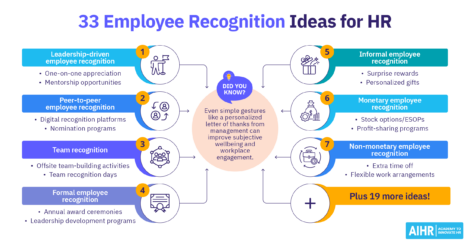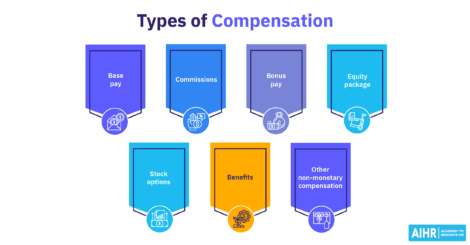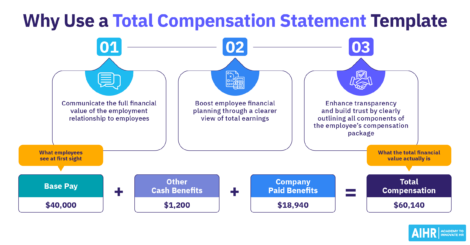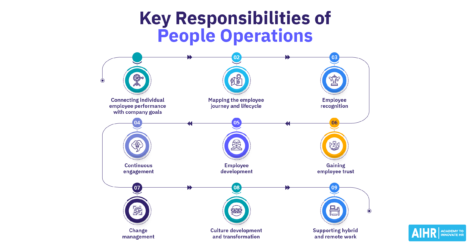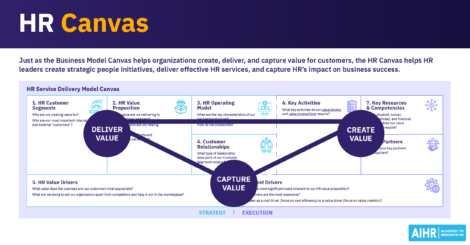Your Guide To Creating a Salary Increase Letter (Plus Free Templates)
The growing skills gap and labor shortages has created a candidate and employee-driven market. The result: Worker’s salary expectations have changed, and stagnant wages just won’t cut it when retaining employees. We give you top tips on when (and how) to create a salary increase letter.

When an employee has been performing well—whether that’s hitting key targets or reaching important milestones—it might be time to send out a salary increase letter. This letter not only communicates the good news but also serves as a great opportunity for HR to outline any new responsibilities that come with the raise. Plus, this document can act as a useful reference point for managers and HR teams when it comes time to review salaries again in the future.
Let’s take a look at all you need to know about salary increase letters.
Contents
What is a salary increase letter?
When is a salary increase letter created?
What is HR’s role in salary increases?
Checklist: How to write a salary increase letter
Salary increase letter templates
FAQ
What is a salary increase letter?
A salary increase letter, also known as a pay increase letter, is a formal document an employer provides to an employee to communicate an increase in the employee’s salary. It is usually issued by the HR department and serves as an official record of the salary adjustment.
The increase letter provides the employee with details about their new wage and the effective date of the increase. It typically outlines the reason for the raise and may reflect the employer’s recognition of the employee’s value to the company, performance, or changes in the market.
When is a salary increase letter created?
Let’s take a look at the various situations when salary increase letters are issued and how to make the most of them as an HR professional:
- Annual performance reviews: Linking salary increases to performance outcomes is a tangible and measurable way of tracking how well an employee has met their key performance indicators (KPIs). A salary increase letter is also an excellent way to say well done and thank you, with an attached reward, adding more recognition and value to the overall employee experience.
- Merit-based increases: Employers may reward employees with a salary increase for exceptional work performance, achievements, or contributions that go above and beyond their regular job duties. This does not necessarily need to align with a performance review.
- Promotions: When an employee is promoted to a higher position, a salary increase letter is given to reflect the new responsibilities and the higher level of compensation associated with the new role. It is a measurable way to ensure the employer and the employee agree on the new job scope, aligned with the latest compensation and benefits.
- Job changes: A salary increase letter formalizes the change if an employee transitions to a different role within the company that warrants a higher salary.
- Market adjustments: Companies may adjust salaries to align with the current market rates for specific roles to remain competitive and retain talent.
- Cost of living adjustments: To accommodate inflation or changes in the cost of living, employers might provide salary increases to ensure that employees’ earnings are sufficient to meet their needs.
- Contractual increases: In some cases, salary increases are predetermined in employment contracts or collective bargaining agreements, and a salary increase letter is provided when these increases are applied.
A salary increase letter helps ensure transparency around compensation between the employee and the employer. Beyond communicating the new salary conditions and related expectations, it can also be used as a great motivational tool and can positively affect employee job satisfaction and company loyalty. As an HR professional, you can use a salary increase letter not just to reward performance but also to reinforce your company’s culture and values, making employees feel both recognized and connected to the bigger picture.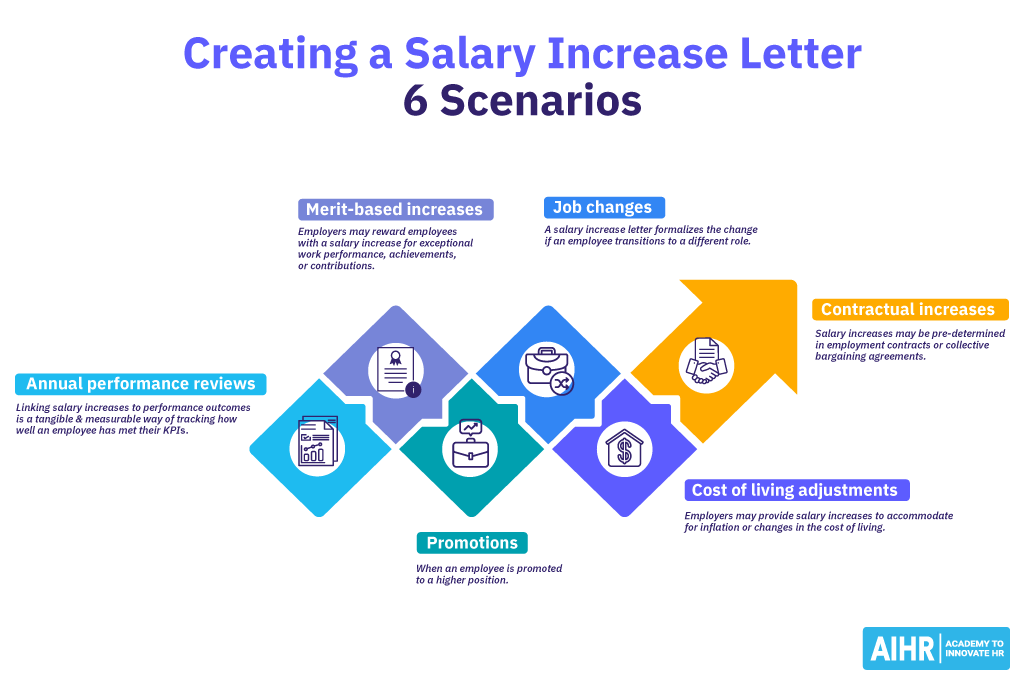
What is HR’s role in salary increases?
As an HR professional, you play a critical role in the process of salary increases within your organization.
The HR department is instrumental in developing, implementing, and overseeing compensation strategies that align with a company’s goals and budgetary constraints. In larger organizations, this includes setting pay grades and salary ranges that match job roles within the organization and ensuring that if an employee moves into a new salary band, their compensation is adjusted accordingly.
HR professionals typically work closely with department managers to evaluate employee performance. This collaborative process helps to determine which employees are eligible for raises based on performance metrics and other predetermined criteria. Managers may also rely on your expertise to understand a reasonable performance increase in various positions.
It’s up to you to ensure that the organization’s salaries are competitive. Conduct market research, study industry standards, analyze job market trends, and gather data on pay practices to inform salary decisions.
Once a decision is made, HR is also responsible for communicating salary increases to employees, which is where the salary increase letter comes in. This involves drafting clear and concise communications that detail the new compensation, the reasons for the increase, and the effective date.
HR tip
Make sure all salary increase decisions are compliant with local, state, and federal employment laws and regulations, including equal pay acts, minimum wage laws, and anti-discrimination laws.
Checklist: How to write a salary increase letter
Step 1: Plan your letter
Jot down who is receiving the letter, why they are getting a salary increase, and what the increase is. Include any additional requirements or job responsibilities.
→ Do this:
- Check with the line manager about what to include in the salary increase letter, such as dates of the new salary increase, new job responsibilities, or any other information specific to the employee.
Step 2: Create an outline for the letter
Create a clear structure for the salary adjustment letter. Start with an opening paragraph, followed by the body of the letter where the main points are explained, and end with a concluding section that congratulates the employee or provides any additional information.
→ Do this:
- Start by capturing key details in bullet points before writing the letter to ensure you have covered all critical points.
Step 3: Write the salary increase letter
It’s time to flesh out your key points and create your written communication. Ensure all key areas are complete:
- Begin the letter by addressing the employee, including the company’s name, address, and date of sending
- Craft a concise introduction in a paragraph to set the tone for the letter and highlight the main points
- Develop the body of the letter to explain the salary increase, including details such as the percentage increase, the previous salary, and the new salary
- Next, expand on the reason for the increase. Either highlight the employee’s key performance and how it is being rewarded, a change in position and job responsibilities, or a response to market changes
- Write the conclusion paragraph. Include the start date of the salary increase and the contact information of a person to whom they can ask any questions regarding any administrative steps.
→ Do this:
- Double-check that your written draft covers every bullet point in your outline.
Step 4: Proofread the letter
Read your letter carefully, revise it, and make changes if needed. You should also ask someone from the team to read the letter since they can offer a fresh perspective on the details and potentially notice any gaps or mistakes.
→ Do this
- Use a free online grammar tool to highlight any spelling errors or typos.
HR tip
A salary increase letter not only notifies employees of a raise but also reinforces the employer-employee relationship. Craft it with care and attention to detail. Here are a couple of tips:
- Avoid ambiguity about the salary increase amount and the effective date
- Use positive language to reinforce the value of the employee to the company
- Remind the employee that the details of the salary increase are confidential
- Check the letter for any spelling or grammatical errors to maintain professionalism.
- Deliver the salary increase letter in a timely manner, preferably soon after any verbal communication about the raise.
Salary increase letter templates
We’ve put together a variety of salary increase letter templates tailored to different scenarios, such as general raises, merit increases, and promotions. Each template is designed to help you effectively communicate salary changes while recognizing employee contributions and maintaining transparency.
You can also download them as Word documents for easy customization.
1. General salary increase letter template
A general salary increase letter is used to inform an employee of an upcoming raise in their salary, acknowledging their contributions and outlining the new compensation details.
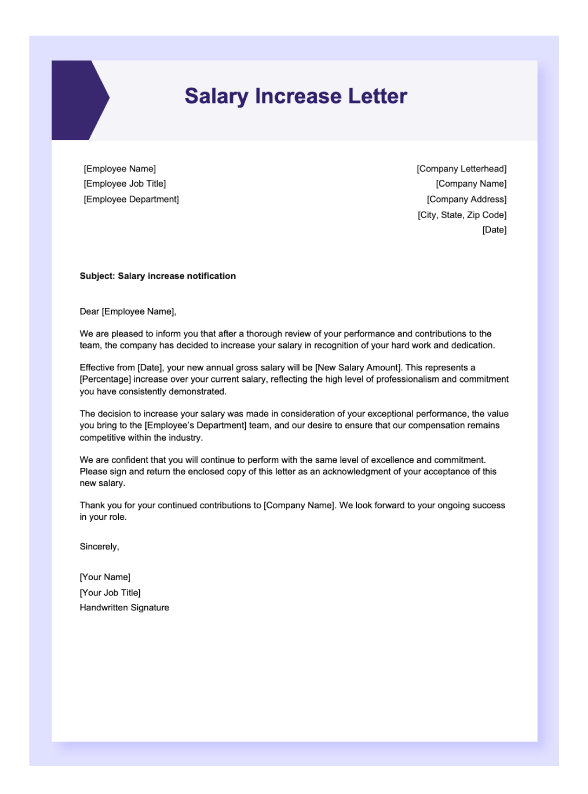
2. Merit increase letter sample
A merit increase letter is issued when you reward an employee for their exceptional performance by providing a raise that reflects their hard work, dedication, and contributions to the company.
3. Market adjustment salary increase letter sample
This letter is used to notify an employee of a salary adjustment made to align their compensation with current market standards, ensuring competitiveness within the industry.
4. Promotion and salary increase letter to employee
This letter informs an employee of their well-deserved promotion and accompanying salary increase, detailing new responsibilities and recognizing their exceptional contributions.
A final word
Developing a clear communication strategy around salary increases, including issuing salary increase letters, is key to ensuring transparency and understanding across the organization. By training managers to handle compensation discussions, regularly updating the compensation plan to reflect economic and industry changes, and establishing feedback mechanisms, you can create a more informed and engaged workforce.
You might also consider introducing tools like a salary increase simulation. This can help managers make better-informed decisions while balancing departmental budgets and company-wide financial goals.
FAQ
To write a letter for a salary increase, follow a structured and professional format:
– Start with the company’s letterhead to ensure authenticity, and include the date at the top of the letter. Address the letter directly to the employee with their name, job title, and department.
– Begin with a warm opening and then proceed to state the purpose of the letter clearly: to inform the employee of the salary increase.
– Specify the amount of the raise, the new total salary, and the effective date of the change.
– Provide a rationale for the increase, whether it’s due to performance, a promotion, or other factors. Express appreciation for the employee’s contributions and encourage their continued success.
– Conclude with instructions for any required actions, such as signing and returning an acknowledgment. Close the letter with a formal sign-off, your name, title, and a handwritten signature.
– Ensure the language is clear, concise, and free from ambiguity to maintain transparency and understanding.
To document a salary increase properly, HR must first record the adjustment in the employee’s personnel file, detailing the new salary amount, the effective date, and the reason for the increase. This should be accompanied by the signed salary increase letter as evidence of communication and acceptance. Next, update the employee’s compensation information in the HR information system to ensure accurate payroll processing and alignment with internal records.
It’s also crucial to revise any related documents, such as benefits information, if they are affected by salary changes. Ensure compliance with data protection laws when handling such sensitive information. All documentation should be thorough, precise, and securely stored to maintain a clear audit trail and to support any future references or decisions regarding employee compensation.
Notifying an employee of a pay increase should be handled with care to ensure clarity and maintain a positive impact. It typically involves a two-step communication process: First, a direct conversation with the employee, usually in a private meeting where the manager or HR representative can verbally communicate the salary increase, explaining the rationale and acknowledging the employee’s contributions. This personal approach allows for immediate dialogue and the opportunity to address any questions.
Following the meeting, the verbal notification is formalized through a written salary increase letter, which details the raise amount, new salary, effective date, and any other relevant changes to the compensation package. The letter serves as an official record of the increase and should be presented to the employee for acknowledgment and kept in their personnel file. It’s important that the notification is handled discretely and respectfully to preserve confidentiality.
Learn more
Related articles
Are you ready for the future of HR?
Learn modern and relevant HR skills, online







